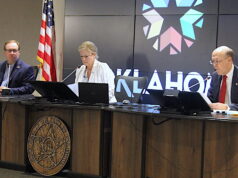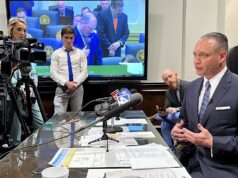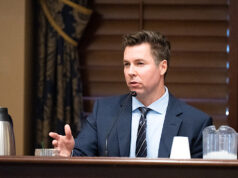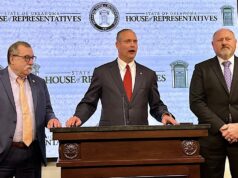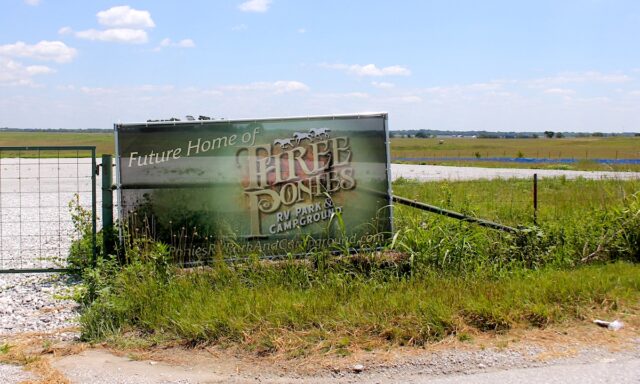

Building big things can be hard to do.
In Oklahoma City, a new publicly funded basketball arena for the OKC Thunder has an architect and a contractual obligation to open by June 2030. Plans for the new Oklahoma County Jail, however, are less clear as the city and the county prepare for a court date in unusual litigation between government jurisdictions.
The proposed American Heartland Theme Park, meanwhile, is having even less success. Dogged by financial liens on the property annexed into the city limits of Vinita last year, the Missouri-based company pitching the pricy attraction is not doing interviews about the latest delay.
You can learn about all of those news items, some energy industry updates and more in the following roundup.
Dubious theme park project officially delayed

While not waving the white flag of surrender, developers of the proposed American Heartland Theme Park in Vinita are sounding retreat.
Fifteen months after holding a news conference attended by public officials and more than 900 people to announce their venture, officials with the American Heartland Theme Park and Resort are saying the project’s opening is being pushed back at least three years, according to a report in the Tulsa World.
The project, originally pegged at $2 billion but raised to an estimated cost of $2.5 billion, was intended to open in 2026. Construction was originally planned to start this year.
The setback, however, was hardly surprising. Work halted earlier this year on a companion project by the developers, Mansion Entertainment Group. The Missouri-based company held a groundbreaking Oct. 30, 2023, for the Three Ponies RV Park and Campground about a mile north of the proposed theme park. Gravel was applied earlier this year as a staging area for construction equipment, but except for some plastic fencing little else has changed. The RV park, described as a luxury outdoor resort destination featuring 300 cabins and 750 RV sites, was scheduled to open next year.
On May 3, a Canadian firm hired to design the theme park filed a lien in Craig County District Court against Mansion Entertainment claiming it is owed nearly $5.5 million from unpaid invoices.
FORREC, with headquarters in Toronto, Canada, filed a mechanic and materialsmen lien claiming it had not received payment on design work and planning for the American Heartland Theme Park and Resort, as well as its associated Three Ponies RV Park and Campground. A materialman’s lien is basically a mechanics lien for material suppliers that provides them with a security interest in the real estate on which a project takes place.
Also named in the claim against Mansion Entertainment is OGB Holdings, which is identified in documents as owning the real property and premises of both the theme park and RV campground. OGB Holdings is either a subsidiary of or controlled by a subsidiary of Mansion Entertainment, according to court papers. FORREC said it is owed $1.6 million design work done for the theme park, $2.2 million for design work for a hotel and indoor water park and $1.5 million for design work for the RV campground.
On May 29, Crossland Construction Company filed a similar claim against Mansion Entertainment and OGB Holdings alleging it is owed $352,429 for labor performed and materials furnished in February for the RV park and campground. The company also is seeking interest and attorneys’ fees. Crossland claimed it performed work totaling $480,723 and that Mansion Entertainment paid only $128,293, leaving an unpaid balance of $352,429.
The last update Mansion Entertainment posted on its Three Ponies RV park Facebook page came July 27, and it only featured a comment on a large fire that heavily damaged a senior living center in Vinita.
Top officials with Mansion Entertainment appeared at the April 16 Vinita City Council meeting to explain the delay in construction occurring at the RV park.
“Some of you may have noticed that the RV park is lagging a little behind, and that’s my fault. I’m sorry,” Steve Hedrik, American Heartland executive producer of project development, told council members. “I asked the designers to compress the RV park. We still have 750 RV spaces and 300 cabins, but I wanted to get out of the floodplain, the FEMA floodplain, what I call in the south 40. It’s probably only 20 acres, but I wanted to get out of that area, and I challenged them to compress it. Some of our RV spaces were 80 feet long, which is excessive, so I asked them to subdivide those and (…) surprisingly enough, the smaller you make it, the more affordable it is.”
American Heartland received another setback in May when legislators declined to approve a requested $35 million appropriation earmarked for water and wastewater improvements in land recently annexed by Vinita, which included the theme park and RV park.
Kristy Adams, Mansion Entertainment’s executive vice president of marketing, said in an email Thursday she had no information to provide.
“I’m sorry but we are not giving any new interviews right now, but you can reiterate what was said in the previous discussions regarding our delay with the change in the RV park footprint,” she said. “Steve Hedrick gave (a) detailed explanation on this during numerous interviews and the same would be said today.”
In the Tulsa World article published Thursday, Adams said once work started on the RV park it would take another three years to build the theme park.
Gene Bicknell, the project’s founder and chief creative officer, provided a statement to the Tulsa World.
“We are continuing to move forward,” said Bicknell, 92. “We have had some temporary challenges to overcome, but we are confident that we will be back on track soon.”
Dennis Speigel, the founder and CEO of Cincinnati-based International Theme Park Services, Inc., previously expressed skepticism about the viability of the American Heartland proposal in rural northeast Oklahoma.
“It’ll never happen, I told you that a year ago,” he said Thursday. “It was never realistic from the beginning. … This is their way of bowing out. There is not a market out there for that park. It’s a shame for the state to waste their time and effort on something that will never come to fruition because it doesn’t have the infrastructure to support it.”
New Thunder arena plans take shape
The Oklahoma City Council on Oct. 22 selected MANICA Architecture as the design architect for the new $1 billion arena that will be home to the Oklahoma City Thunder and occasional concert events.
MANICA has designed a host of sports arenas in the NFL and NBA, including the new Nissan Stadium being built riverside in Nashville. Atlanta-based TVS was selected by the council to be the architect of record for the development of the new arena. The architects have not yet presented renderings of the new facility.
The new arena is slated to open in 2028 and will be located on the site of the old Cox Convention Center, which has been occupied by Prairie Surf Studios in recent years. With Prairie Surf’s future uncertain, the old Cox Center is expected to be demolished next year, with construction on the arena likely to begin in 2026. The city has a contractual obligation to open the new arena no later than 2030.
In December 2023, OKC voters approved a 72-month penny sales tax to build a new, publicly funded and city-owned arena that would be home to the Thunder, with the team contributing about $50 million toward its cost. The deal between the city and Thunder was criticized at the time, but voters overwhelmingly approved the measure amid threats the team could leave OKC if no deal was made.
OK County Jail construction could start early next year

Despite the looming potential for legal setbacks, groundbreaking on the new Oklahoma County Jail could begin as early as January with the project completed by the end of 2026, according to a Flintco official who spoke at an Oct. 22 meeting of the county’s Citizen Bond Oversight Committee. Flintco has been selected as general contractor for the now $600 million-plus project, for which the county has dedicated funds equal to less than half that amount.
Ideas being considered by the committee to bridge the funding gap include a possible P3 public-private partnership or an increase in county sales tax. Meanwhile, a court battle between the city and county remains ongoing and could upend the timing of the jail’s completion. The OKC City Council denied a rezoning request earlier this year, and Oklahoma County took the city to court, arguing that its sovereignty as a government entity means it does not need municipal zoning approval to carry out core services like the provision of a jail. The litigation is unresolved, and a pretrial conference has been scheduled for Thursday, Jan. 23.
County engineer Stacey Trumbo told committee members Oct. 22 that the funding gap remains a problem but that he is optimistic it will get solved.
“The funding issue has been the whole problem the whole time, and it still is,” Trumbo told committee members. “It’s frustrating that we don’t have enough money to build what we need to build. We have some plans to move forward. The P3 idea. There are people who are willing to loan us money and I didn’t think we’d get that and we did and we got a pretty good deal and we have just one more step, how do we pay it back. There are some ideas about that. I remain optimistic and positive.”
Interim study previews power policy initiatives in 2025
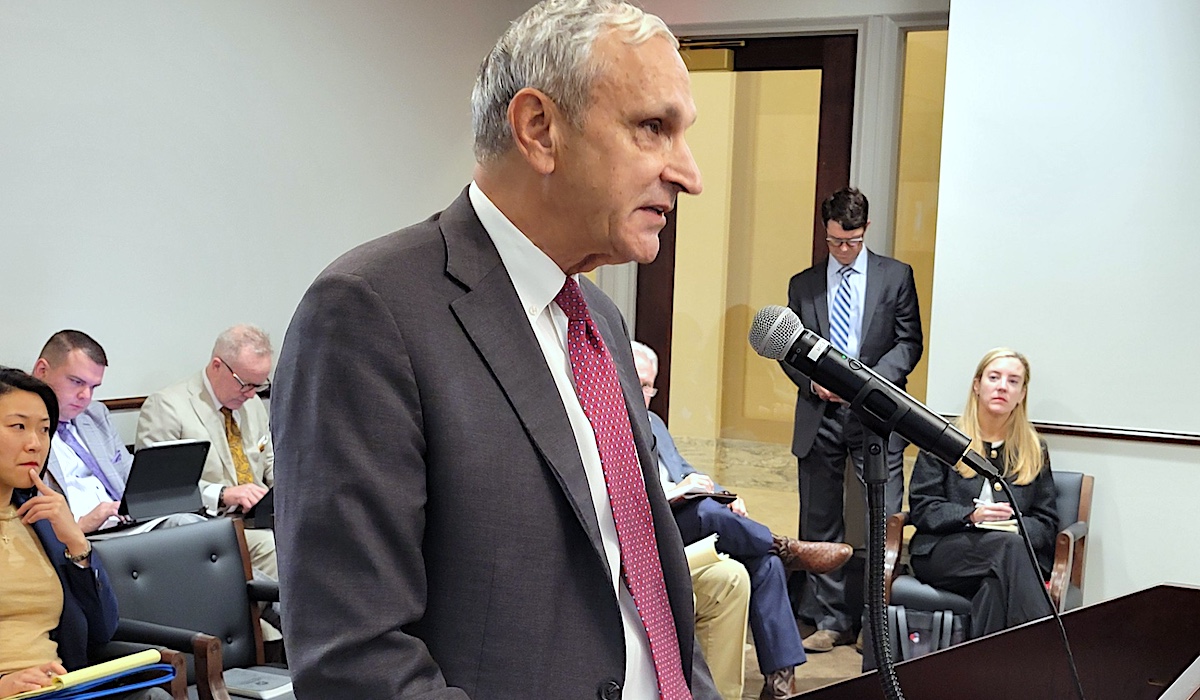
By being among the top 10 states with the lowest electricity rates for business and residential customers, Oklahoma is drawing attention from businesses with high electrical needs — such as manufacturing plants, industrial companies and data centers — and also from lawmakers concerned about the best ways to advance electrical generation for future economic development.
Previewing and portending likely policy decisions facing the Oklahoma Legislature in 2025, the topic received significant discussing during an Oct. 22 interim study conducted by Rep. Brad Boles (R- Marlow) and Rep. Mike Dobrinski (R-Okeene), chairman of the House Utilities Committee.
“We’ve heard that we’re one of the lowest states in cost of electricity in the country, which is great, but back home, taxpayers still want to know why is their bill increasing,” said Boles, chairman of the House Energy and Natural Resources Committee. “I think they respect the fact that we’re lower than most other states, but it doesn’t help the situation that their bills are getting more expensive. So, what can we do to keep our costs low, and what can we do to have better credit reliability going forward, and also position our state for future economic development?”
Customers of the largest utilities in the state, Oklahoma Gas & Electric and Public Service Company of Oklahoma, have seen significant rate increases this year owing to pending settlements with the Oklahoma Corporation Commission. Boles’ and Dobrinski’s interim study featured nearly a dozen representatives from various utilities, electrical associations and advocate groups discussing concerns and laying the groundwork for possible legislation in 2025 on a variety of topics.
Three themes emerged during the nearly three-hour session: keeping costs low; economic development and great reliability. Committee members heard that sometimes those objectives have competing interests.
“We want to give [businesses] what they want to get here, but it can’t be at the expense of the ratepayers,” Boles said. “So, what is that balance where we can achieve all three of those at the maximum efficiency for our state? What I’d like to do is take all that and see what we can do in Oklahoma to have a better energy policy that will keep our costs down. We want to get a data center, we want to get a large industrial company, but we don’t want to build up infrastructure where it’s going to be passed on for our everyday Oklahomans to have an increase in power, just so we could get that data center or that industrial company. So, how can we balance our economy because these are good-paying jobs that we want in Oklahoma? But at the same time, we don’t want our ratepayers to have to pay that cost.”
Ken McQueen, Gov. Kevin Stitt’s secretary of energy and environment, requested the study to examine whether there are any regulatory or statutory impediments that slow the addition of generation and transmission in Oklahoma. In recent sessions, lawmakers have fought over the “right of first refusal” concept for electricity transmission and the idea of deregulating the energy market.
McQueen said Oklahoma is in a fortunate position by having the sixth-lowest business electric rates and the ninth-lowest residential electric rates in the country, according to electricity prices for October from the U.S. Energy Information Administration.
“These attributes are driving significant interest in our state as a place for establishing new businesses,” McQueen said. “Many of these new businesses are enormous power consumers, so we think that future economic development will increasingly depend on not only state incentives, but also the availability of low-cost power bills that are economically priced. States that are agile and proactive in encouraging new generation and transmission will be the states that land these new businesses.”
Matt Horeled, vice president of regulatory and finance for PSO, said lawmakers should focus on three goals: Moving at the speed of business, encouraging new generation, and protecting Oklahoma’s affordability and reliability.
Dan Sullivan, chief executive officer of the Grand River Dam Authority, talked about the need for additional bonding capacity for the state power utility he leads. GRDA’s bonding cap was originally set in the 1970s, and it was increased from $1.41 billion to $2 billion based on 2022 legislation. A significant portion of that increase was dedicated to the financing of a new natural gas unit to replace GRDA’s final coal plant, which is being retired.
“We’re approximately at $1.2 billion of outstanding debt right now,” Sullivan told lawmakers. “We went out to the market for about $520 million to build this new natural gas unit, and we’ll be needing additional opportunities for that going forward. If we want to meet this growing demand, if we want to be the state that’s open for business, then we need the capital to be able to do that.”
While GRDA sells electricity to dozens of municipalities, it also provides power for industrial operations, including businesses at the MidAmerica Industrial Park in Pryor. The relatively affordable and stable electricity prices offered at the site have historically made it Oklahoma’s best opportunity to recruit mega-manufacturing projects.
Casey Cathey, vice president of engineering for the Southwest Power Pool, said more generation is needed in the SPP, a regional transmission organization involved in how electricity is sold and distributed to customers within a multi-state area stretching from Canada to parts of Texas.
In Oklahoma, wind has increased its share of the fuel mix for electrical generation, Cathey said. In 2023, wind made up 48.1 percent of the state’s fuel generation, natural gas makes up 44.2 percent and hydroelectric power generates about a half percent. Solar resources are yet to be online in meaningful numbers, he said.
Cathey said the process of getting new generation projects from the drawing board to reality is a lengthy one. It can take two to four years to get SPP approval and another four to eight years for utilities and generation developers to get the projects built and approved.
Dan Sullivan discloses ‘personal issue’ to GRDA board
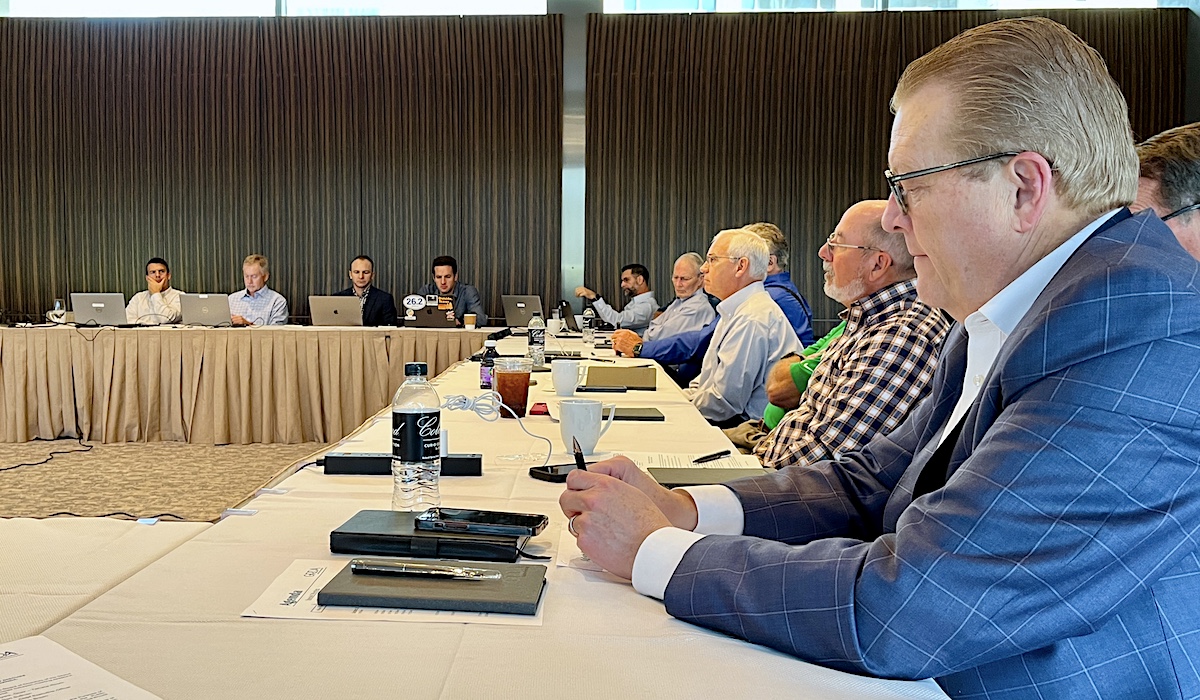
While the Grand River Dam Authority is working to establish greater electricity generation capacity, private actions of the state public power utility’s CEO have sparked renewed interest in a decade-old settlement.
Dan Sullivan, who exited the Oklahoma House to become GRDA’s president in 2011, has informed the GRDA Board of Directors of a “personal issue” involving marital infidelity that he said does not involve the state agency or its other employees.
“I am remorseful and embarrassed by my behavior related to a personal matter. I regret the harm it has had on my family and those who have placed their trust in me. I recognize that my conduct was not aligned with the values I strive to uphold,” Sullivan said in a statement. ” I fully acknowledge that I let myself and others down, and for that, I am deeply sorry. I humbly ask for prayers and support, not only for myself and my family, but also for all those impacted by my actions.”
NonDoc has chosen not to publish specific details of the familial situation facing Sullivan, as it appears not to involve employees of the state agency or entities that do business with GRDA.
“I have discussed this matter with our board of directors,” Sullivan said. “I wanted to make them aware of this personal issue and assure them that it has no connection to GRDA or anyone associated with GRDA. My actions have not compromised my dedication to my job or my role in leading the Grand River Dam Authority. We have continued to make great strides these past few months, and have many challenges ahead of us as an organization.”
Sullivan and the agency have faced challenges before. In 2014, GRDA paid $925,000 to settle a sexual harassment lawsuit and a wrongful termination lawsuit filed against Sullivan and the agency. The Tulsa World reported that the sexual harassment claim was settled for $223,000. The GRDA said details of the settlement were confidential, according to an agency spokesman at the time.
The wrongful termination suit was brought by former Chief Operating Officer Mike Kiefner, who claimed he was forced out in 2013 partly because he knew of alleged advances made by Sullivan toward a female coworker. GRDA directors reportedly ordered an investigation and approved the $223,000 settlement with the woman involved, who had resigned from her position with the utility.
Sullivan is a former Republican state legislator from Tulsa who was elected to the Oklahoma House of Representatives in 2004. He resigned in November 2011 to take the GRDA post. While in the Legislature, he was involved in a heated divorce in 2007 and 2008. His ex-wife claimed he was ineligible to hold his legislative seat because he had moved out of the district, and he had to pay $7,000 in delinquent property taxes on a Tulsa home.
“Over the past 13 years leading GRDA, I have been incredibly proud of the accomplishments we have achieved,” Sullivan said in his statement. “I am honored to lead such an exceptional team, whose contributions have and continue to be, central to GRDA’s proven success and positive impact for Oklahoma.”
With a $540,000 salary, Sullivan is one of Oklahoma’s top-paid state employees who do not coach football, although he is an attorney.
John Wiscaver, GRDA’s executive vice president of strategic communications, said Sullivan told the board about his “personal matter” because he believed it “warranted disclosure.”
“Sullivan has informed the board this matter does not involve GRDA or anyone associated with GRDA,” Wiscaver said. “Given the personal nature of this issue, GRDA will not be sharing any additional details.”
Court of Criminal Appeals overturns old ‘knock and announce’ rule
In a new opinion released Oct. 24, the Oklahoma Court of Criminal Appeals has held that a police officer’s violation of the “knock and announce” rule does not require the suppression of evidence obtained in a subsequent search. Judge Gary Lumpkin wrote the court’s opinion in Oklahoma v. Velasquez, which incorporates the U.S. Supreme Court decision Hudson v. Michigan into Oklahoma law.
According to Lumpkin, the Hudson decision established a two-part test for determining whether a court should suppress evidence when an officer violates the “knock and announce” rule while serving a warrant. In order for evidence to be suppressed, it must be evidence that would not have been obtained “but for” the violation of the “knock and announce” rule, and the need to deter the constitutional violation must “outweigh” the “substantial social costs” of suppressing evidence.
The decision makes it extremely difficult for a criminal defendant to suppress evidence seized by police officers who violate the “knock and announce” rule. Lumpkin’s opinion also explicitly overturned parts of three prior decisions incompatible with the Hudson ruling: Brumsfield v. State (2007), Erickson v. State (1979) and Sears v. State (1974).
Presiding Judge Scott Rowland wrote separately and noted the Legislature’s role in telling courts when to suppress evidence.
“When our Legislature intends to suppress evidence for violation of a certain statute, it does so unequivocally and without aid of this court,” Rowland wrote.
Vice Presiding Judge William Musseman also wrote separately to criticize the majority opinion for overturning the district judge for abuse of discretion instead of reviewing the case de novo, or without any deference to the district court’s decision.
Biden calls Indian boarding schools ‘a sin on our soul’
President Joe Biden’s administration formally apologized for the United States Indian boarding school policy Oct. 25 at the Gila River Indian Community in Arizona. The U.S. federal government created Indian boarding schools across the country and frequently compelled or coerced Native American families to send their children to them well into the 20th century.
Boarding schools notoriously had an unacceptably high student mortality rate paired with poor record keeping about burials. They also actively suppressed the use of Native American languages, leading to the extinction of some and the endangerment of many others. Tribal governments have invested millions of dollars into reversing language loss directly attributable to boarding schools.
Biden’s Friday event opened with Gila River Indian Community Gov. Stephen Roe Lewis, who praised the presidential administration’s investment in Indian Country across the United States.
“All of these federal programs empower tribal governments to work in true partnership with the administration and to bring the solutions we know will benefit all our tribal communities,” Lewis said. “Because when our community thrives, all of America thrives.”
U.S. Secretary of Interior Deb Haaland contrasted the colloquial notion of an elite boarding school with the reality of the federal boarding school policy.
“For much of this country, boarding schools are places where affluent families send their children for an exclusive education,” Haaland said. “For Indigenous peoples, they served as places of trauma and terror for more than 100 years. Tens of thousands of Indigenous children as young as 4 years old were taken from their families and communities and forced into boarding schools run by the U.S. government and religious institutions. These federal Indian boarding schools have impacted every Indigenous person I know.”
Biden called the federal Indian boarding school policy “a sin on our soul.”
“After 150 years, the United States government eventually stopped the program, but the federal government has never, never formally apologized for what happened until today. I formally apologize as president of the United States for what we did,” Biden said. “I have a solemn responsibility to be the first president to formally apologize to native peoples, Native Americans, Native Hawaiians and Native Alaskans.”
About halfway through his speech, Biden was interrupted by a protester. As the crowd booed, Biden instructed them to let the woman speak.
“How can you apologize for a genocide while committing a genocide in Palestine?” the protestor asked before shouting, “Free Palestine.”
Biden appeared to instruct security to “let her go.”
“There is a lot of innocent people being killed. There’s a lot of innocent people being killed, and it has to stop,” Biden said before continuing with his speech.
Although Biden’s formal apology marks a historic first for the nation, Native American families whose ancestors attended Oklahoma’s Riverside Boarding School have yet to learn whether there will be a search for unmarked graves near the school, which is located just north of Anadarko. While Riverside Indian School is now widely viewed as a positive institution for Indigenous students, its historic operations featured similar stories of abuse and cultural eradication. Haaland conducted a listening session at Riverside in 2022, but her administration has repeatedly declined to answer questions about requests that school property be searched for unmarked graves.
Senate conducts interim study on phones in schools
During their 2025 regular session that will start in February, legislators appear likely to revisit conversations about restrictions for cellphones in schools. Senate Education Committee Chairman Adam Pugh (R-Edmond) led a two-day interim study earlier this month to hear from experts and educators about the negative effects of digital media and prolonged phone use on Oklahoma’s youth.
On Oct. 22, presentations from neuroscientists, psychology experts, and Oklahoma teachers supported the idea that cellphones are inhibiting productive learning environments and contributing to anxiety, depression and loneliness.
“In the end, we allow them because they’re small and they fit in our pockets, and so we don’t think it’s a distraction to kids,” Pugh said. “We don’t think it’s a mental health issue for kids. We don’t think it’s hurting academic outcomes for kids or decreasing the ability for kids to interact with each other in a way that produces empathy and understanding and patience and kindness and all the soft skills that we as members of the Education Committee are recognizing are lacking in young people today. (…) The data is quite overwhelming that these cell phones, while having tremendous benefit to how we live in modern society, also have tremendous cost to how people interact with each other.”
Discussions around the impacts of cellphones in schools began last year as Pugh authored Senate Bill 1314 requiring all Oklahoma public school districts to adopt a phone-free campus policy prohibiting students from using phones during the school day. The Senate education and appropriations committees approved SB1314, but the bill dissolved before crossing over to the Oklahoma House of Representatives.
“This is actually a really simple solution, but I think the implementation is difficult, as we’ve shown over the last year,” said Vice Chairwoman Ally Seifried (R-Claremore). “There are a lot of different takes on how to best get cell phones out of the classroom, but I’ve been really encouraged that the consensus has generally been (that) it’s time to get them out of the classroom.”
On Sept. 11, Gov. Kevin Stitt issued an executive order challenging all Oklahoma school district superintendents to adopt “cost neutral” phone-free policies. Stitt wrote that the challenge is meant to encourage “policy makers to experiment with commonsense solutions to a real and worsening problem.”
The order prescribed a Nov. 29 deadline for any school districts participating in the challenge to share the implemented policies with Stitt’s administration.
Pugh said he and other lawmakers intend to propose legislation in 2025 for statewide cellphone restrictions in schools, something he said has growing support from teachers, parents and even students, according to a survey conducted by Oklahoma Union Public Schools Superintendent Brenda Taylor, who presented information to the committee.










